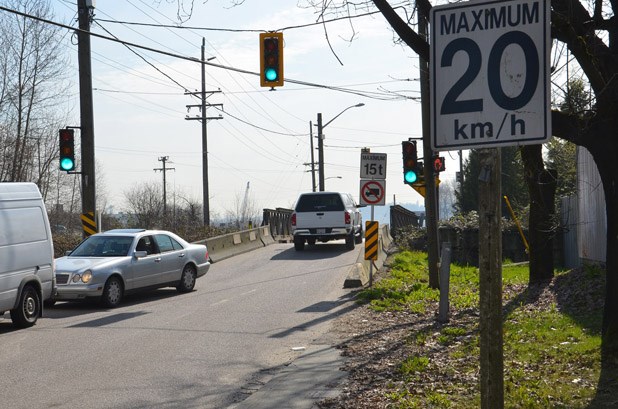The Bailey Bridge is proving to be a bridge over troubled water.
The City of New Westminster is declining Transportation Minister Todd Stone’s offer to lend the city a temporary crossing for the Bailey Bridge but only if the city agrees to allow two lanes to be installed in the area that connects New Westminster to Coquitlam. In a May 14 letter to Stone, the city states the two crossings would be contrary to the city’s position of opposing an expansion of capacity in Braid Street corridor.
“We had hoped to have this important alternate access restored quickly, given the previous commitment by ministry staff of the use of a temporary bridge without the condition of increasing capacity, and have already spent over $30,000 in material and equipment in anticipation of its arrival,” stated the letter from Mayor Wayne Wright. “Therefore, we respectfully ask in the name of health and safety, that this commitment be honoured.”
The city is asking the ministry to decide by May 20 if the temporary Bailey Bridge in its Cloverdale facility can be released for this purpose.
“Optionally, in order to respect the integrity of the province’s arbitration process, the ministry could provide a single temporary Bailey Bridge immediately and postpone any decision on an additional bridge until the independent arbitrator has had an opportunity to render a decision,” stated the letter.
Last week, Stone informed the city that the ministry is seeking support for installing a single-lane bridge at the site, which would allow single-lane alternating traffic this summer. In addition, planning would begin so a second single-lane bridge could be installed at the site this fall.
The Braid Street Bailey Bridge has been a longstanding conflict between the cities of New Westminster and Coquitlam, with New West wanting a single lane crossing and Coquitlam wanting expanded capacity. An arbitrator has been appointed to consider the matter and is expected to make a decision in June.
In a letter to Stone, Wright points out that the arbitrator’s decision must be handed down no later than July 1. As a result the city has chosen to “respectfully decline” the minister’s proposal for two crossings.
“You are correct that, prior to its failure, over 10,000 vehicles were using the bridge daily. It is important to note that before Coquitlam unilaterally expanded United Boulevard to four lanes and extended it to the bridge in 2002, only a few hundred vehicles used the bridge on a daily basis,” Wright stated. “Today, most crossings consist of commuter traffic choosing to use Braid Street, rather than the 12 traffic lanes now available after the recent expansion projects on the immediately adjacent Highway 1 and Lougheed Highway corridors.”
According to Wright, the majority of the additional traffic on Bride Street must pass through the Brunette Avenue intersection, which operates at a service level of “F” for most of the day – the worst rating an intersection can have.
“As a result, this intersection has the highest number of collisions of any in the city, and one of the highest in Metro Vancouver,” he wrote. “Clearly it would be extremely unwise to exacerbate this situation by facilitating an increase in the number of vehicles entering this already heavily congested intersection.”
The city’s letter also states that access to the area is “potentially unsafe” because of the five grade-level rails crossings at Braid Street.
“Adding additional capacity would only make the situation worse,” stated the letter. “A recent study conducted for the cities of Coquitlam and New Westminster found that a two-lane crossing could see an increase of traffic up to 80 per cent, which would raise congestion back to unacceptable levels.”
The Bailey Bridge has been closed to vehicles since the beginning of March, after engineers deemed it to be structurally unsound. On Monday night, council members expressed concern about the minister’s demands that the city accept a second crossing and about the fact he’s supporting Coquitlam’s position in a matter that is before an arbitrator and subject to biding arbitration.
Stone told The Recordlast week that a two-lane crossing should have been installed years ago. He doesn't think an additional lane will increase traffic through the area.



